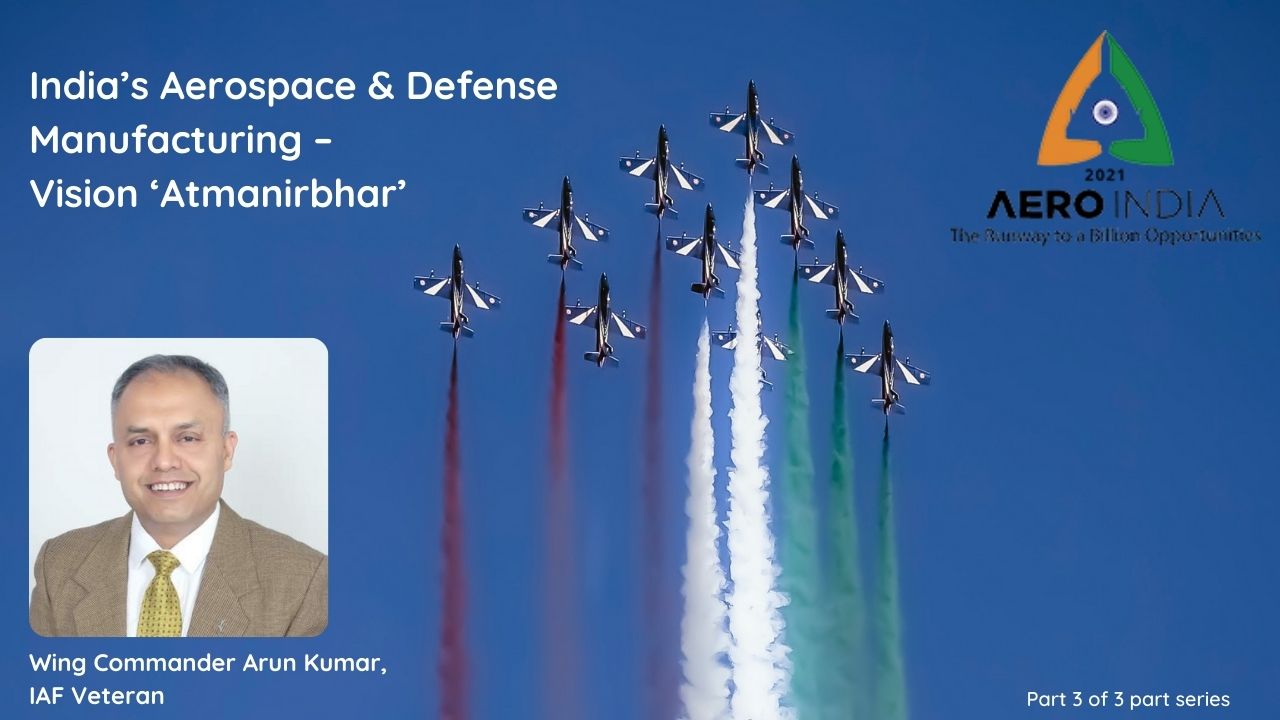India’s Aerospace & Defense Manufacturing – Vision ‘Atmanirbhar’ – Part 3
#Leadership #Defence #Aerospace
Manufacturing Challenges for the Indian A&D Industry
Access to Technology:
➢ Technology expertise is the most critical challenge faced by the Indian companies especially keeping pace with the increasingly high use across the design lifecycle. Foreign companies are reluctant to transfer cutting edge technologies with limited management control in the Indian entity and in the past, have given licenses for older technologies.
Raw Material Development Capabilities
➢ The composition of materials used in aircraft manufacturing is migrating towards new advanced materials. The use of composite materials is rapidly becoming a mainstay since they result in lower maintenance costs, lighter aircraft and higher fuel efficiency. Currently, almost all raw materials are being imported by Indian suppliers. In the field of advanced materials, novel processing and material characterization methodologies are still emerging. To enhance application of composites as critical performance material, the Department of Science & Technology (DST), GoI has been taking several initiatives.
Access to Funding
➢ The aerospace business is highly capital intensive. In the initial high growth phase, capital needs to be injected rapidly and continuously to maintain the planned growth rate. Additionally, working capital requirements, market development, brand building and awareness require significant on-going investment and expenditure. Funding access can act as an entry barrier into this space.
Lack of Skills
➢ While the number of engineering students graduating every year is very large, an issue that arises is their lack of employability. Consequently, companies have to invest significantly to make fresh recruits “industry-ready” with the right kind of skills / training.
Quality Issues
➢ Quality assurance and reliability are essential in aerospace technologies due to stringent requirements of weight-to-strength considerations and the need for highly reliable systems. The industry works on a zero defect target. While Indian manufacturing has improved significantly in quality control, a mature supplier base is still developing in India and the inability of smaller suppliers to keep abreast with the rising quality issues could become a problem for the Indian aerospace companies.
Certification Process
➢ Getting international airworthiness certifications for processes and parts has been a challenge for India-based suppliers. It is also a deterrent for OEMs to outsource some of their components to India since the approval for parts made in India can sometimes take too long and become cost inefficient (includes logistics costs). However, the approvals for international airworthiness of parts manufactured by Indian manufacturers still do not occur within the country. Indian companies need support from the Govt through bilateral arrangements with international certification agencies.
NADCAP
➢ NADCAP (National Aerospace and Defense Contractors Accreditation Program) is a global cooperative standards-setting program for aerospace engineering, Defense and related industries. The program gives accreditation for special processes in aerospace and military industry such as heat treatment, chemical processing etc. This accreditation is required and accepted by several leading players like Boeing, GE, Honeywell etc.
AS9100
➢ AS9100 is a widely adopted quality management system standard for the aerospace industry. Most major aerospace manufacturers and suppliers worldwide require compliance and/or registration to AS9100 as a condition of doing business with them.
Road Map For An ‘Atmanirbhar’ A&D Industry
A&D and Aviation sectors contribute significantly to the National GDP in general world-over and it is thus imperative for GoI / Ministry, A&D Corporate Bodies and Industry to ensure the sustenance of its economic safety, continued growth and prosperity.
The Indian Aerospace Industry is one of the fastest-growing aerospace markets in the world with HNIs, Corporates and Airlines placing orders for an increased number of aircraft. Massive investments in all areas of the sector need to be made for India to actualise its potential. The growth of airlines and passenger traffic in India has been highly rapid in the past 5 years at over 15% PA, increasing from around 70 to 200 million passengers in the past decade of domestic / international air travel, considering 2020-21 as exception. The Ministry of Civil Aviation estimates that the Indian aerospace industry needs investment more than USD150 billion over the next 15 years.
Globally, India ranks among the top countries on Defense expenditure. The GoI has announced a capital allocation of USD 14 Billion towards modernization of the Army, Navy and Air Force.
NEWSLETTER
TRENDING ON PRO MFG
MORE FROM THE SECTION



